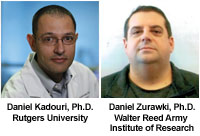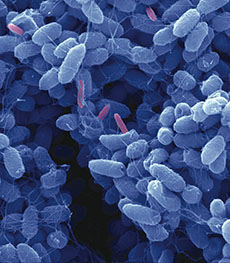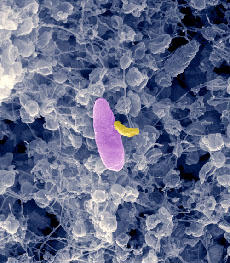Military Infectious Diseases Research Program (JPC-2)
Fighting Bacteria with Bacteria: Controlling Wound Infections with Predatory Bacteria



Posted March 29, 2016
Daniel Kadouri, Ph.D., Rutgers University
 Disease-causing microorganisms that have become resistant to drug therapy are an increasing cause of burn, wound, blast and bone infections, with many traditional antimicrobial agents becoming ineffective. Multidrug-resistant (MDR) bacteria are a prominent problem for wounds succumbing to infections, especially in Wounded Warriors. To address this issue, researchers have studied several antibacterial approaches to treat MDR pathogens which are no longer susceptible to traditional antibiotics, including biological control of MDR bacteria growth with medical maggots and phage.
Disease-causing microorganisms that have become resistant to drug therapy are an increasing cause of burn, wound, blast and bone infections, with many traditional antimicrobial agents becoming ineffective. Multidrug-resistant (MDR) bacteria are a prominent problem for wounds succumbing to infections, especially in Wounded Warriors. To address this issue, researchers have studied several antibacterial approaches to treat MDR pathogens which are no longer susceptible to traditional antibiotics, including biological control of MDR bacteria growth with medical maggots and phage.
Another biological control strategy has led Principal Investigator (PI) Dr. Daniel Kadouri of Rutgers University and collaborating PI Dr. Daniel Zurawski of Walter Reed Army Institute of Research to envision using predatory bacteria to control the growth of MDR bacteria. Drs. Kadouri and Zurawski are particularly interested in Bdellovibrio bacteriovorus (Figure 1) and Micavibrio aeruginosavorus (Figure 2) predatory bacteria. Dr. Kadouri have shown in studies previously funded by the DoD1 that these two predatory bacteria are able to prey on various pathogens, including bacteria found in infected wounds of Wounded Warriors.
With support from the Military Infectious Diseases Research Program (MIDRP) beginning in 2012, Drs. Kadouri and Zurawski have been able to further their research by studying the interactions and resistance between predatory and prey bacteria, investigating whether the two particular predatory bacteria of interest are safe and efficient for use in animals prior to testing in humans. Dr. Kadouri has reported optimistic findings that host bacteria and biofilm-forming bacteria do not develop genetically stable resistance towards either predatory bacterium. After acclimation, predatory bacteria are able to prey on bacteria even at fever-like temperatures. Furthermore, the two predatory bacteria do not attack already-resistant bacteria. Dr. Kadouri also noted that the two predatory bacteria were able to attach to cultured human skin cells without inducing cell morphological changes or cell toxicity. Preliminary mice studies with inflicted surface wounds treated with predatory bacteria did not show signs of any adverse effects; however, treatment as-is did not significantly improve wound healing. Nevertheless, Dr. Kadouri's work demonstrates that topical application of predatory bacteria to wounds may be a promising alternative live therapeutic for fighting infections with MDR bacteria. Dr. Kadouri plans to perform additional animal studies to more thoroughly investigate and improve the safety and efficacy of these two predatory bacteria as a means to promote wound healing.
1 Contract W81XWH-07-1-0350

Figure 1. Scanning electron micrograph of Bdellovibrio bacteriovorus (pink) penetrating into an E. coli biofilms (blue).

Figure 2. Scanning electron micrograph of Micavibrio aeruginosavorus (yellow) preying on Pseudomonas aeruginosa growing in a biofilm.
Publication:
Shatzkes K, Chae R, Tang C, Ramirez GC, Mukherjee S, Tsenova L, Connell ND, and Kadouri DE. 2015. Examining the safety of respiratory and intravenous inoculation of Bdellovibrio bacteriovorus and Micavibrio aeruginosavorus in a mouse model. Scientific Reports 5:12899. doi: 10.1038/srep12899. PMID: 26250699.
Other related publications:
Shanks RM and Kadouri DE. 2014. Predatory prokaryotes wage war against eye infections. Future Microbiology 9(4):429-432. doi: 10.2217/fmb.14.19. Review. PMID: 24810340.
Kadouri DE, To K, Shanks RM, and Doi Y. 2013. Predatory bacteria: a potential ally against multidrug-resistant Gram-negative pathogens. PLoS One 8(5):e63397. doi: 10.1371/journal.pone.0063397. PMID: 23650563.
Shanks RM, Davra VR, Romanowski EG, Brothers KM, Stella NA, Godboley D, and Kadouri DE. 2013. An eye to a kill: Using predatory bacteria to control gram-negative pathogens associated with ocular infections. PLoS One 8(6):e66723. PMID: 23824756.
Links:
Last updated Thursday, December 5, 2024














